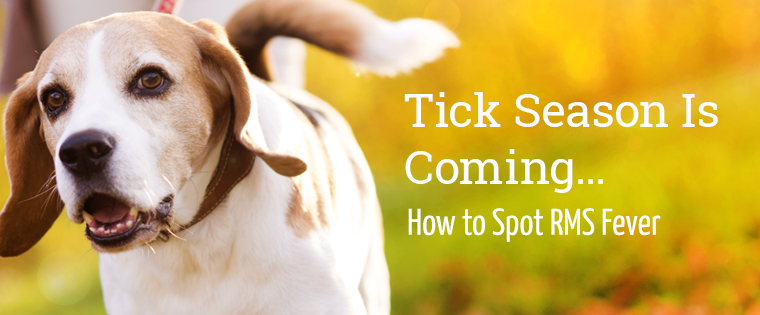Rocky Mountain spotted fever is a disease carried by ticks that can affect dogs and humans. Despite its name, you don’t have to live in the Rockies to risk exposure – the ticks that carry it are found along the East Coast and in the Midwest and Plains regions.
How is the disease spread?
The fever is carried in an intracellular parasite, Rickettsia rickettsii, that lives in the American dog tick (commonly found in the East Coast) and the Rocky Mountain spotted fever tick (from which it gets its name).
Dogs or humans can get the fever when an infected tick attaches to a host for 5-20 hours. Only infected ticks carry the disease, and not all ticks carry Rocky Mountain Spotted fever. The disease can also be carried by rodents, foxes and raccoons who have been bitten by an infected tick.
Because ticks are most active and feeding in the warm months of April to September, this is the most common time that the disease is transmitted.
How do I know if my dog has Rocky Mountain spotted fever?
First, your dog may have the disease and not show symptoms. This is called the “subclinical” version of the fever. Specialized laboratory tests would show the infection, but you likely would not have noticed it.
The “acute” version of the fever, however, causes symptoms that unfortunately also seem to point to other conditions. Infected dogs may show depression, muscle pain, fever, reduced appetite, or edema (accumulated fluid) in the face or legs. Some dogs may vomit or have diarrhea; others may seem dizzy or disoriented. Many dogs will develop red spots (from hemorrhages) in their eyes and possibly blood in the stool. Renal (kidney) failure and seizures may occur in severe cases.
Symptoms begin to show 2-14 days after the tick bite, so it can be hard to link your sick dog to the cause. So if the weather is warm and your dog shows signs of illness, visit your vet right away.
How will my vet check for Rocky Mountain spotted fever?
We will look for a combination of clinical signs, ask about a history of possible tick exposure, and then perform basic blood work. If we suspect Rocky Mountain spotted fever, we will perform further tests to see if your dog is producing antibodies to R. rickettsii.
Is Rocky Mountain spotted fever treatable in dogs?
Yes, with a proper diagnosis, dogs can be treated for this disease. We will prescribe an antibiotic to take for 10-14 days. Some dogs may begin to recover immediately, and most dogs will fully recover upon completing the antibiotics.
Dogs with more severe cases or those who were not promptly diagnosed may need care for severe shock or nervous system problems. Some dog breeds, including German Shepherds and English Springer Spaniels, are more likely to have severe forms of the disease.
The good news is that dogs who recover from Rocky Mountain spotted fever seem immune to getting the disease again.
If my dog has Rocky Mountain spotted fever, will I get it?
Humans can get Rocky Mountain spotted fever—but only by being bit by an infected tick. So the only way your dog could give it to you is if your dog carries infected ticks that then bite you.
Symptoms in humans include: fever, headache, chills, rash and muscle aches. Some people also experience nausea and stomach pain. See your doctor right away if you suspect you may have been bitten by an infected tick.
How can I prevent my dog from getting Rocky Mountain spotted fever?
The best way to prevent this tick-spread disease is to control for ticks. At Animal Clinic of Woodruff, we recommend regular doses of tick prevention medication, like Bravecto or Nexgard. Since mice and rats can also carry the disease, be sure to control for rodents in areas where your dog sleeps and plays.
If your dog has been outdoors in areas that have lots of ticks, do a complete body check before allowing him back in the house. Be sure to follow tips on how to safely remove ticks from dogs.
And if you suspect your dog may have been bitten, schedule an appointment with Animal Clinic of Woodruff right away.













